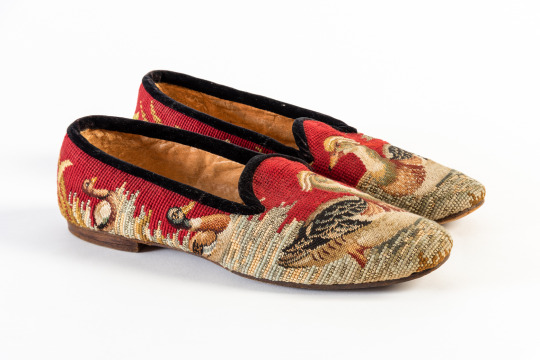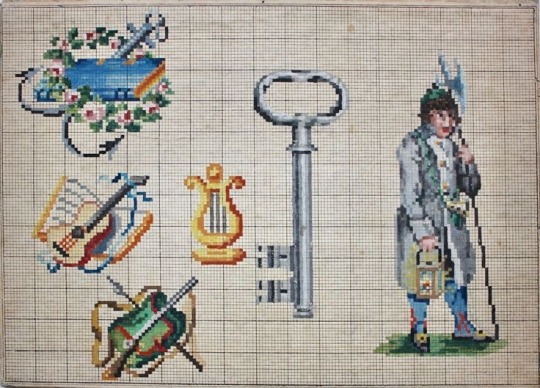#berlin woolwork
Photo


Men’s Slippers
1880s
Fashion Museum Bath via Twitter
#slippers#fashion history#historical fashion#1880s#menswear#mensfashion#victorian#victorian fashion#1880#1885#1889#ducks#embroidery#berlin woolwork#united kingdom#shoes#accessories#fashion museum bath#popular
2K notes
·
View notes
Text
This is delightful. I love all the examples!
My favourites:

Long gown with Ayrshire work (detail), maker unknown, 1820 – 30, Scotland. Museum no. CIRC.410-1924. © Victoria and Albert Museum, London

Chinese silk embroidered panel (detail), maker unknown, 18th century, China. Museum no. T.171-1948. © Victoria and Albert Museum, London

Handkerchief with cutwork (detail), maker unknown, 1600, Italy. Museum no. 288-1906. © Victoria and Albert Museum, London
180 notes
·
View notes
Text
Pair of Shoes

Pair of shoes of embroidered canvas in coloured wools in Berlin woolwork, England, ca. 1850
Victoria & Albert Museum
#19th century fashion#19th century#shoes#1850s fashion#historical fashion#victorian#victorian era#victorian fashion
21 notes
·
View notes
Photo

Medieval Hunt colored by Matt Engdahl.
“I have a thing for antique patterns (not everyone's cup of tea!), and have restored/traced some old 19th century Berlin Woolwork ones.”
9 notes
·
View notes
Text
If I finally learn needlework solely for the purposes of making myself a fetching pair of Berlin woolwork braces for an outfit I’m not even done sewing… my ancestors are gonna be laughing.
3 notes
·
View notes
Text


Men's embroidered slippers, second half of the 19th century. An example of the style known as Berlin wool work, they are embroidered in wool thread on a canvas ground. (The John Bright Collection).
#victorian#embroidery#men's fashion#fashion history#historical men's fashion#berlin wool work#dress history#slippers#extant#victorian fashion#i assume the pair with naval ensigns is pre-1864 it still has the three colour squadron flags#woolwork
30 notes
·
View notes
Photo

House Shoes: Keeping the Outdoors Out for Centuries
“Take your shoes off! And keep your feet off the couch!” Different cultures have different approaches to indoor vs outdoor footwear, but I bet most people heard a variation on that imperative from their mother growing up. For the Atlantic, Margarita Gokun-Silver wrote a piece on the traceable history and cultural implications of the house slipper, which has appeared in art since at least the Renaissance. Among the things I learned: in some parts of the world, people wore “house shoes” all the time, and your outdoor shoes were worn over them, then removed when you came in.
"...the conquests of the Ottoman Empire brought Eastern habits into the European continent. “[Most Ottoman people] were wearing outdoor shoes over the indoor shoes like galoshes,” explains Lale Gorunur, the curator of the Sadberk Hanim Museum in Istanbul. “But they’d never go indoors with outdoor shoes. They’d always take off the outdoor shoes at the gate of the house.” Territories under the empire’s rule seemed to adopt this habit, and slippers remain common in countries like Serbia and Hungary.”
Shoes like those pictured above were created in the Victorian era, often by women who used a technique known as Berlin woolwork to craft an upper, which was then brought to a shoemaker to add a sole, and then gave them as gifts to their husbands. Sort of the needlepoint belt of the era?
I have a pair of Birkenstocks I use for house shoes, although I admit that on occasion I’ve stepped out on the stoop with them. Don’t tell my mom.
28 notes
·
View notes
Text

ENGLISH SCHOOL
GOTHIC REVIVAL EMBROIDERED BERLIN WOOLWORK PANEL, CIRCA 1850
depicting a lady at prayer, original frame
Lyon and Turnbull
74 notes
·
View notes
Photo

Sampler worked in wool on canvas, believed to be the work of Sofia Maria von Stockau c.1845-1852.
This elaborate sampler features many elements typical of woolwork samplers of the 1830s and 40s with pictorial motifs including small landscape scenes and realistic posies of flowers. Many of these would have been copied from commercial patterns originally printed in Germany or Austria. The centre of the sampler features an ornate floral alphabet that also appears in several samplers held in other museum collections; it can be identified as a pattern produced by the publisher L.W.Wittich in Berlin first printed in the 1830s. The sampler is mostly worked in very fine cross stitch with a few small areas of canvas work showing filling patterns.
Although the sampler does not feature a name or date, it is believed to be the work of Sofia Maria von Stockau. Sofia was born in 1834 and was the daughter of a German Aristocrat with the title Graf von Stockau, a rank equivalent to the British Count. In the original donation record the maker of the sampler is listed as “Countess Sofia Dubsky”. The sampler was probably made whilst she was studying at the Ladies of the Sacred Heart Convent School in Prague, an exclusive finishing school for aristocratic girls and young women. In 1850 Sofia married Josip Jelačić, a Serbian Lieutenant Field Marshall in the Austrian army and later Ban of Croatia.
This piece was selected as part of The Collection in 60 Objects to celebrate 60 years since the founding of our charity. Use the tag #rbks60 to see the other items we selected.
29 notes
·
View notes
Text
consider it right and becoming for gentlewomen to sit in their ‘parlours,’ do Berlin woolwork, and say nothing
55 notes
·
View notes
Text

#berlin woolwork#embroidery#‘‘men’s pursuits’’ is its own category of old embroidery patterns#they’re all like sport. gun. pipe. an instrument sometimes. keys. card games. + whatever else
54 notes
·
View notes
Link
Miniature with a rose cross stitch pattern small floral berlin woolwork digital format PDF flower embroidery handbag - Cruz - https://arduino.eemuhendis.com/?p=13560
0 notes
Photo

19th Century Berlin Woolwork, hand-painted chart produced by Sajou in Paris.
3 notes
·
View notes
Photo

Parrot sitting on branch with roses Reconstructed according to old tapestry in style of Berlin Woolwork Counted Cross Stitch Pattern PDF
0 notes
